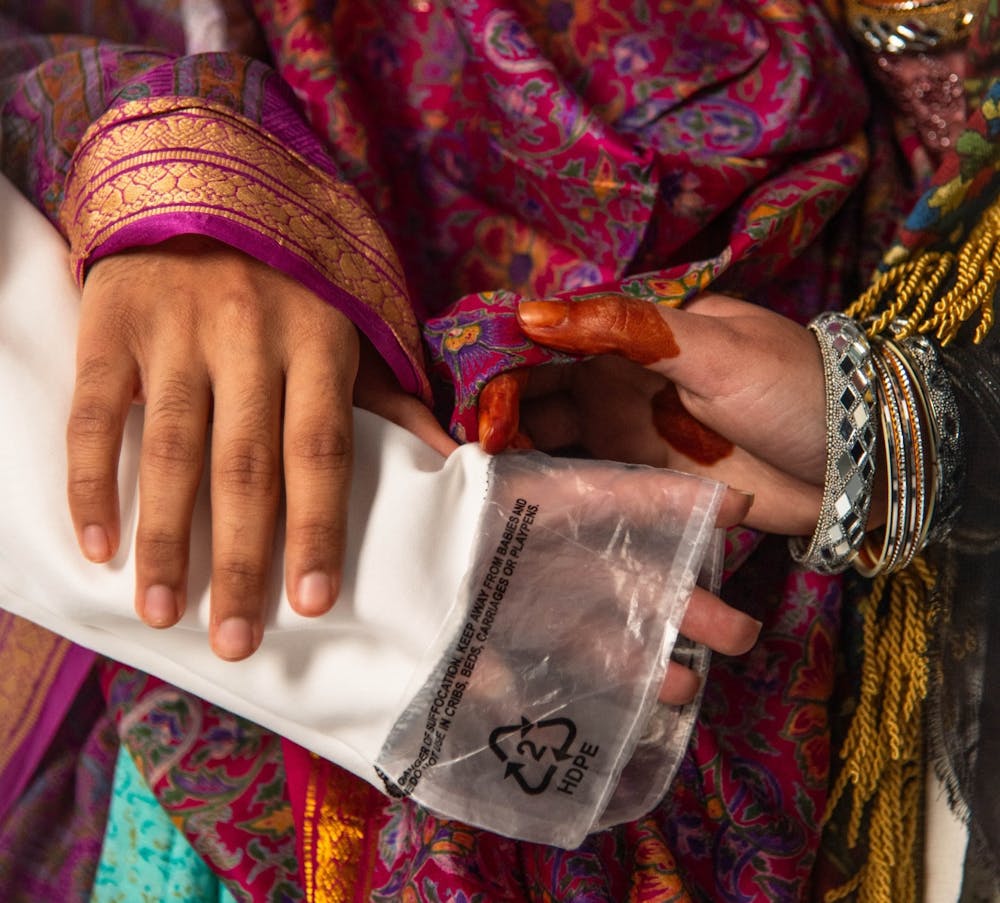How many different textures can you see in a night? How many patterns and shapes? How did the designer think of this? Was this show everything they imagined? Is this something you could ever even imagine without seeing it first?
These were the thoughts running through my head as I sat, dazzled, in the audience of the Maryland Institute College of Art (MICA)’s 30th Annual Benefit Fashion Show. This year’s theme was “Upturn” and was meant to call “upon the artist, and therefore the audience, to question their relationship with society — and ultimately, with themselves.” This is not easy, nor is it comfortable.
While certainly provocative, the designs I saw did not exclude comfort or ease. In fact, the show began on a particularly wholesome note. The opening collection was called “Hyphae-nate,” and was created by designers Austin Chia and Anaitza Brown as a dedication to the creativity of five older residents at the Bolton North Apartments. Each of the seniors proposed and modeled their own outfits, and they were allowed to design whatever they wanted, limited by neither time nor material.
In an interview with The News-Letter, Chia explained, “We tried our best to cater to the interest of each senior. So each senior has different designs to celebrate their own stories, their own personalities.”
Brown expanded on this in an interview with The News-Letter.
“We sat down with each of our models and brainstormed designs right there on the spot. We were sketching and coming up with, you know, what kinds of materials, what kind of colors, what are you interested in, things like that,“ she said.
And so the seniors shone. Each one took the stage in their custom outfits: a stately white lace gown, a colorful happy-go-lucky top and hairdo, a mushroom hat, a sleek gray tuxedo or an aluminum floral dress made entirely of cans. You could tell Chia and Brown honored each detail requested by the models down to the bulbous spires of the mushroom hat. In these get-ups which they conceived and the designers brought to life, the seniors danced down the runway with signature movement and expression.

COURTESY OF MATHILDE MUJANAYI
After this, the music changed, and a new collection took the spotlight. It was called “Cat’s Cradle” and was created by Quinn Spence. In their introductory video, Spence explained that the collection was meant to draw on soft inherited things (family quilts, multigenerational weavings) to explore new directions for healing, and it delivered on that promise. Using the infinitely light and foamy material of mohair and other knit or woven fabrics, Spence draped the models in cozy beauty.
In each of these productions, the designers made sure to devote attention not just to the clothing on the models but to the entire stage. Each collection came with its own temporary environment, carefully curated by the designers to perfectly accompany their work. In the case of “Cat’s Cradle,” the centerpiece was a blanketed table complete with a handmade tea set. As they returned from the runway, the models gathered around this table and took turns pouring out imaginary tea. Everything was made to look gentle and familiar, like a children’s book.
Another carefully heeded aspect of the production was the movement of the models. In contrast to “Cat’s Cradle,” the collection “remember how it felt” made a special effort to make all of its models move stiffly and unnaturally. This made sense, as the collection itself was meant to evoke the feeling of constriction and confinement. In an interview with The News-Letter, designer Sasha Kramer shared that this was her first project in fashion, and that she had spent most of her time working in the sculptural field.
These sculptural, structural sensibilities definitely came through in Kramer’s collection. Each model was dressed in jagged enclosures of striped organza fabric, wrapped up in ways that were obviously uncomfortable. Some were carrying purses made of cement and metal, which Kramer said was meant to juxtapose the sheerness of the fabric. As they moved, they resisted any fluid movement, staggering across the stage like sculptures brought reluctantly to life.

COURTESY OF MATHILDE MUJANAYI
Part of what made this collection so cohesive and beautiful was the amount of labor that went into it.
When asked about her greatest challenge in creating the collection, Kramer said, “I think, honestly, just the amount of repetitive motions that I had to go through ... like sewing each one of the individual sleeves was definitely a lot more work than I was expecting.”
Not only was this work labor-intensive, but it was also time-consuming. Kramer shared that she had been in the studio for eight to 12 hours almost every day for the past three months.
In an interview with The News-Letter, another designer, Solli Kim stated, “I spent more than four months [on this project]. It depends on the day, but usually I work for 10 hours per day for three days a week.”
For all of the students, this project was additional to their regular coursework, so they had to find extra time to work on it — yet they were able to stay meticulous, ensuring that their final product was meaningful. Kim’s own project, titled “stain of you,” was a smudge-embellished streetwear collection made of umbrella plastic and other fabrics.

COURTESY OF MATHILDE MUJANAYI
A thank you to Mathilde Mujanayi for sharing her photos with The News-Letter, as well as student director Abel Reyes for connecting me to the designers.





